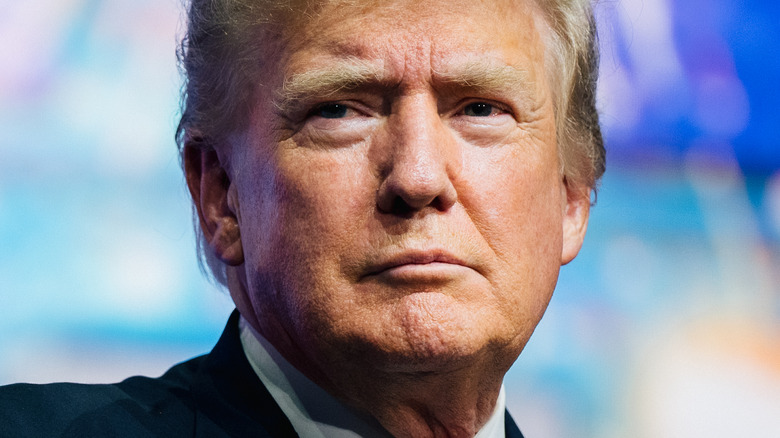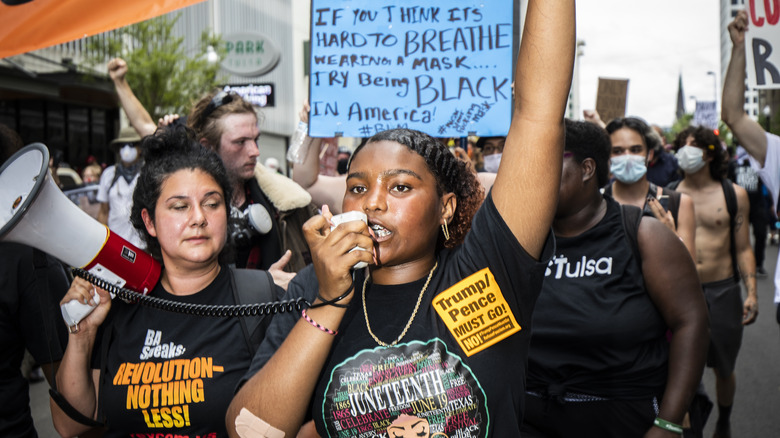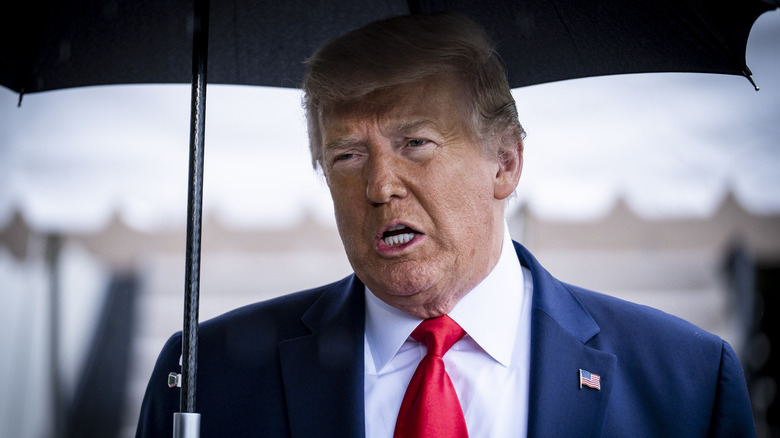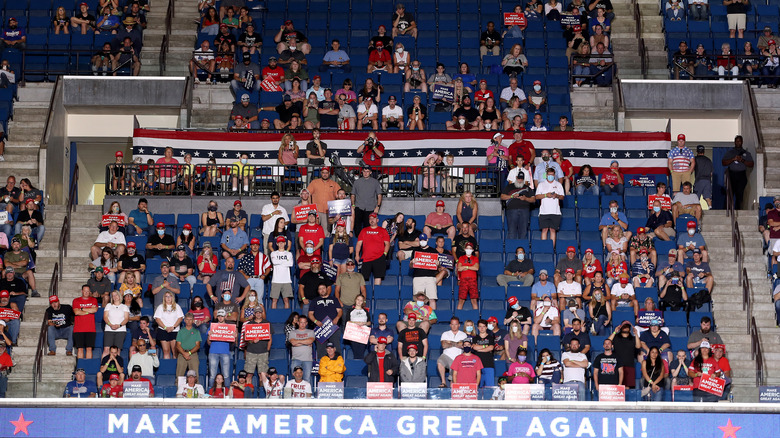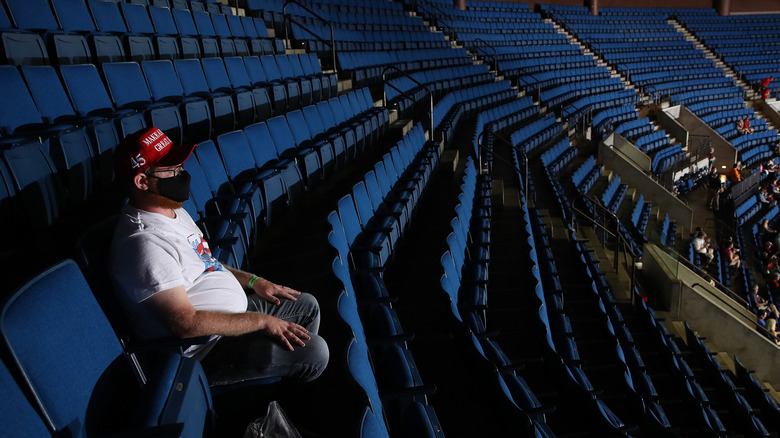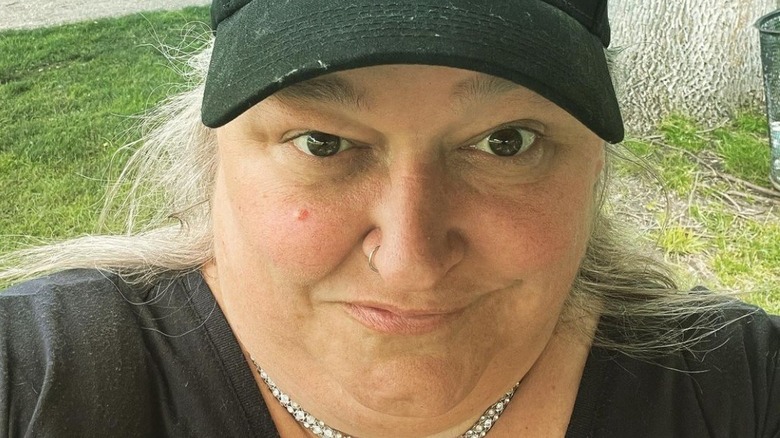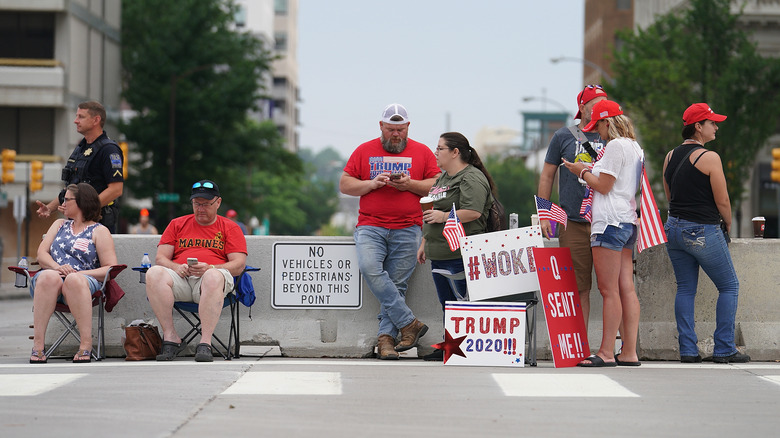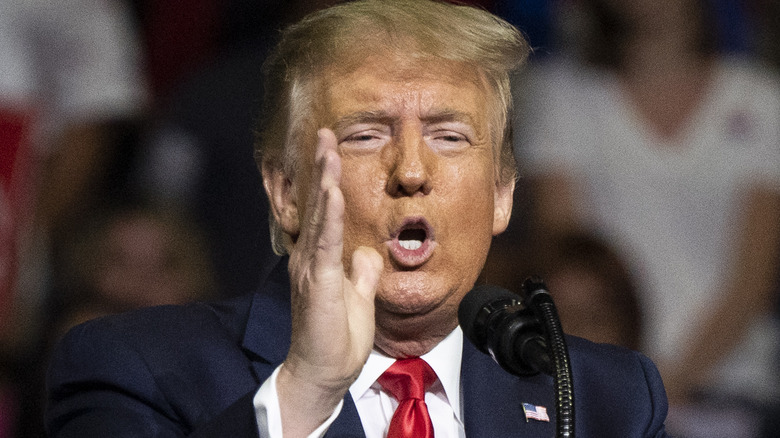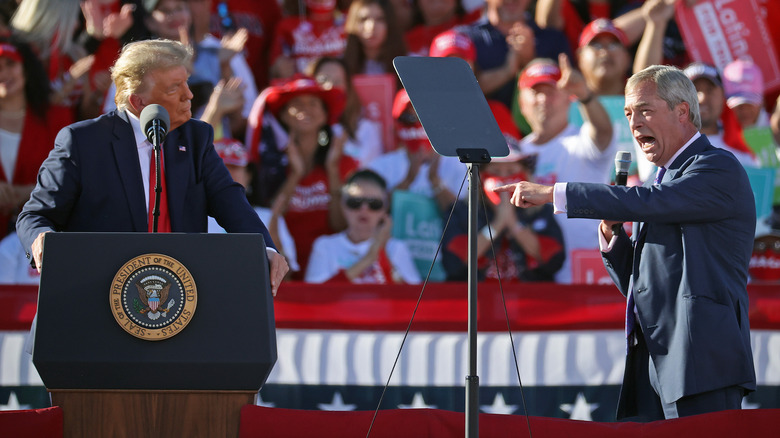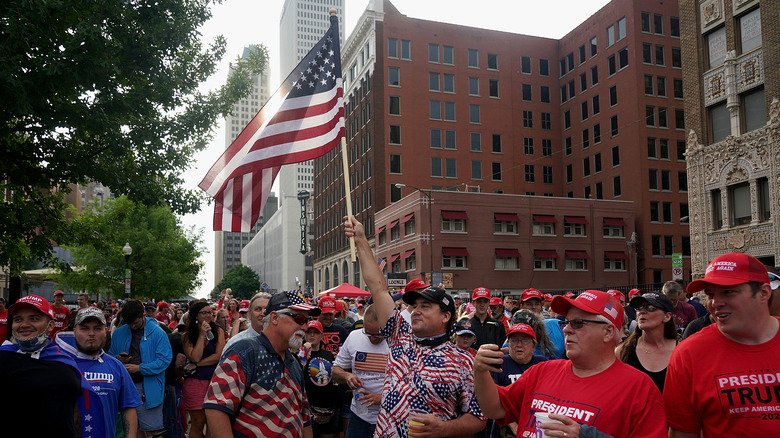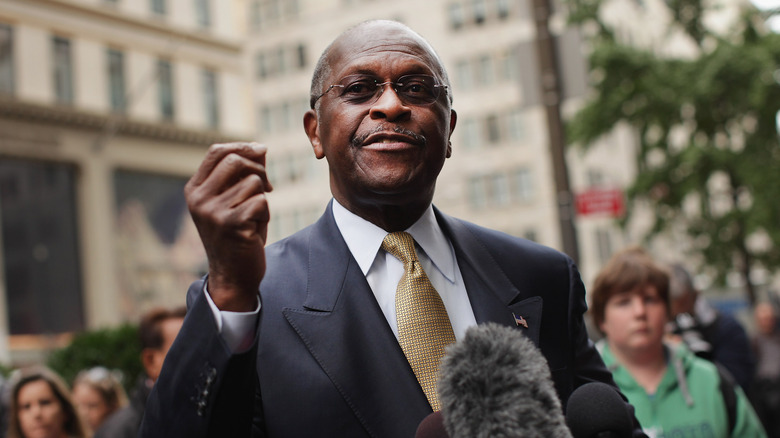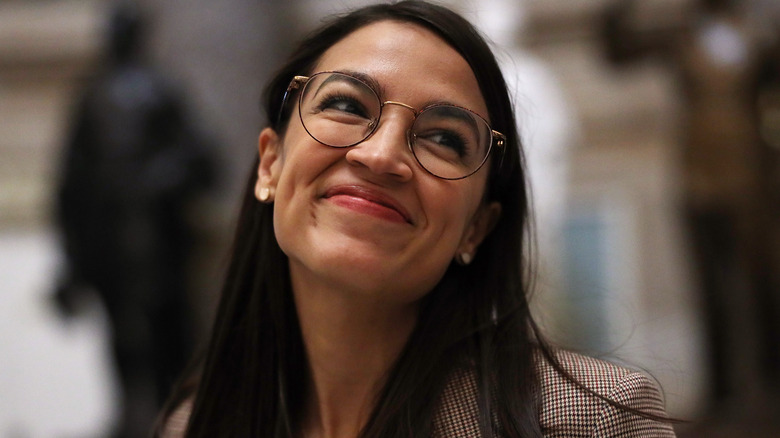Trump's TikTok-Pranked Oklahoma Rally Was Worse Than We Thought
Raucous rallies became a staple of Donald Trump's first run for the White House, and he would host them just as enthusiastically during his time in office. The coronavirus pandemic brought his campaign for a second term to a grinding halt in 2020, making the kind of large-scale gatherings that he thrives on a danger to public health. They were still considered dangerous by medical professionals when Trump announced that he was holding a June comeback rally in Tulsa, Oklahoma. The Harvard Global Health Institute's director told the Associated Press in no uncertain terms that Trump's Tulsa rally was "an extraordinarily dangerous move," and Dr. Anthony Fauci, the president's own chief medical advisor, admitted to ABC News that mass gatherings were still "risky."
The rally went ahead, and it quickly became memorable for all the wrong reasons — at least, from Donald Trump's perspective. The event was the target of a covert campaign by TikTok users, who registered for tickets with no intention of turning up, leaving the president facing a stadium less than a third full. Trump's campaign manager, Brad Parscale, played down the interference in a statement (via Politico), but we've since learned that all hell broke loose behind the scenes. According to "Peril," the 2021 book by The Washington Post's Bob Woodward and Robert Costa, Trump was absolutely furious, calling the rally the "biggest f*cking mistake."
From its controversial beginnings to all the new revelations, here's what we know about Trump's doomed Tulsa rally.
The rally was originally scheduled to take place on Juneteenth
When it was announced that Donald Trump would hold his first rally since the onset of the coronavirus on June 19, 2020, the backlash was instant. People were angry that the advice of high-ranking medical professionals was being ignored, but they were also furious about the chosen date. As Trump's campaign team knew all too well (they "discussed in advance the possible reaction," the Associated Press reported), June 19 is Juneteenth, a holiday commemorating the end of slavery in the United States. The location of the rally was just as controversial, and would later become the scene of protests.
It was in Tulsa that a notorious attack on a thriving African American community took place in 1921. Black Oklahomans had built a highly prosperous business district that was known as Black Wall Street, but a white mob laid waste to it over two days of deadly riots. As many as 300 people lost their lives in what became known as the Tulsa Race Massacre. The rally was "a slap in the face," according to the president of Tulsa's Black Wall Street Chamber of Commerce (via the AP). "To choose the date, to come to Tulsa, is totally disrespectful," said Sherry Gamble Smith. Her sentiments were echoed by the local newspaper Tulsa World, which said that it was wrong for Trump to "be rallying in a city that 99 years ago was the site of a bloody race massacre."
Trump moved the rally back a day as pressure mounted
Donald Trump and his team initially stood their ground as calls for them to move the date of the rally mounted, with the president's senior advisor telling reporters that, "As the party of Lincoln, Republicans are proud of the history of Juneteenth" (per the Associated Press). The president's opponents weren't buying it, and neither were reporters. In a tweet, future VP Kamala Harris accused Trump of trying to send more than "a wink to white supremacists," but "a welcome home party." Joshua Adams of NBC News suggested that not only was holding the rally in Tulsa on Juneteenth a calculated move, it also wasn't the first time that Trump had used such tactics.
"Trump announced rollbacks of LGBTQ health care rights on the fourth anniversary of the Pulse massacre, when a gunman killed 49 people at a gay nightclub in Orlando, Florida," Adams pointed out. "He is also going to accept the Republican Party's nomination on the 60th anniversary of 'Ax Handle Saturday' in Jacksonville, Florida — when civil rights activists and protesters were attacked by white mobs wielding ax handles and baseball bats." Trump, who was already under fire for his reaction to protests over the death of George Floyd, chose to back down.
Taking to Twitter, the former president revealed that he had decided to change the date after his "African American 'friends and supporters'" kindly reminded him that it clashed with the important holiday (via NBC News). The rally was moved to the 20th, but the trouble was just beginning for Trump.
TikTok users claimed responsibility for the rally's poor turnout
In a tweet on June 15, 2020, Donald Trump's campaign manager, Brad Parscale, revealed that over a million people had requested tickets for Trump's upcoming Tulsa rally. It was a figure that the president himself boasted of when he spoke to veteran reporter Bob Woodward just days before the ill-fated event. According to Woodward and Robert Costa's book, "Peril," Trump said "over 1.2 million have signed up," and he was thrilled about it. "Think of that," he added. "Nobody ever had rallies like that." The former president was both surprised and angered when he saw the low turnout for himself, despite having been warned in advance, The New York Times noted.
According to the Tulsa Fire Department, just 6,200 of the people who registered for tickets showed up. It soon came to light that TikTok users had sabotaged the rally by registering for tickets en masse, fooling Trump's campaign team. "I got two tickets but I totally forgot that I have to pick every individual piece of lint off of my room floor and then sort them by size, so I can't make it," one joked. According to "Peril," Trump was heard fuming about the prank in the Oval Office. "I shouldn't have ever done that f*cking, f*cking rally," he's quoted as saying. He reportedly called his campaign manager a "f*cking moron" in the aftermath, laying the blame at his feet. Parscale was shown the door a few weeks later.
How K-pop fans did their bit to sabotage the rally
The true power of K-pop fan armies was on full display in 2020, when supporters of BTS matched a $1 million donation the band made to the Black Lives Matter movement. A few weeks later, K-pop fans mobilized against Donald Trump's controversial Tulsa rally, hoping to embarrass the former president. According to K-pop academic CedarBough Saeji, many of the people who helped pull off the now-infamous ticket prank were young Americans. "The English-speaking K-pop fans who are getting involved in this, who are up on these issues, these are not foreigners," Saeji told The New York Times. "These are exactly the kind of people who are the opposite of the Trump audience that claps when he disses 'Parasite' and says that 'Gone With the Wind' is a real movie," she added.
But how did they pull it off, exactly? The message "spread mostly through Alt TikTok," YouTuber Elijah Daniel told The New York Times. "We kept it on the quiet side where people do pranks and a lot of activism," he explained, continuing. "K-pop Twitter and Alt TikTok have a good alliance where they spread information amongst each other very quickly." According to Daniel, a major part of the strategy was deleting videos after 24 hours, which minimized the chances of them going viral and, in turn, being seen by the wrong people. "We didn't want the Trump campaign to catch wind," he said. "These kids are smart, and they thought of everything."
The no-show idea began with an Iowa grandma
The fact that TikTok teens and K-pop fans had run a covert campaign against Donald Trump's rally made a lot of headlines in the days that followed the disastrous event, but the idea of registering for tickets and not showing up actually came from an Iowa woman who became affectionately known as "TikTok grandma." Her real name is Mary Jo Laupp, and she appears to have been the first person to make a TikTok video urging people to troll Trump. "I recommend all of those of us that want to see this 19,000-seat auditorium barely filled or completely empty go reserve tickets now, and leave him standing there alone on the stage," she said. The message resonated with users of Alt TikTok, and the rest is history.
Laupp spent years as an independent voter and only joined the Democrats so she could volunteer on Pete Buttigieg's nomination campaign. When that didn't pan out, she pledged her support to Joe Biden, though she didn't do what she did for the Democratic Party. Speaking to Insider, Laupp said that she was compelled to act when she found out that Trump was planning on restarting his re-election campaign with a Juneteenth rally in Tulsa. "This was always about, for me, the location and the date," she said. Laupp went on to pay tribute to the people who were killed when Black Wall Street was destroyed, adding: "An entire neighborhood was wiped out because of racism."
Trump's outdoor stage was hastily dismantled
Donald Trump's team would later deny that TikTok teens and K-pop fans had anything to do with the Tulsa rally's low turnout. The former president's campaign manager, Brad Parscale, said in a statement that media outlets reporting on the story had "behaved unprofessionally and were willing dupes to the charade" (via Politico). He also said, "Leftists and online trolls doing a victory lap, thinking they somehow impacted rally attendance, don't know what they're talking about or how our rallies work." What cannot be denied, however, is that Trump and his team expected way more people to turn up on the day, and a hastily dismantled outdoor stage is proof of that.
On the morning of the rally, Parscale took to Twitter to share photos of an outdoor stage being erected outside the venue. "This will be the first time that POTUS speaks to BOTH crowds in person — inside and outside," he said. "If you come to the rally and don't get into the BOK Center before it's full, you can still see the president in person!" Of course, with the BOK Center not even a third full, there was no need for an outdoor stage. The area was virtually deserted ten minutes before Mike Pence was due to speak, CNN political correspondent Abby D. Phillip proved with a damning picture. The Washington Post's Dave Weigel witnessed workers dismantling "the overflow speech stage" before Trump had even arrived at the arena.
Donald Trump was 'stunned' when he saw all the empty seats
When it became clear that the rally turnout was going to be far smaller than anticipated, Donald Trump's team got word to the president. He was aboard Air Force One at the time, per The New York Times. When he arrived, he was "stunned," said the newspaper. "...he yelled at aides backstage while looking at the endless rows of empty blue seats in the upper bowl of the stadium, according to four people familiar with what took place." Trump was supposed to take the stage right after Mike Pence, but when the vice president finished speaking, there was no sign of POTUS. Instead, "Mr. Trump's deputy chief of staff, Dan Scavino, peeked out from behind black curtains to scan the fan-free seats in the top rows."
When he did eventually appear from behind the curtains, Trump called the people who had turned out "warriors," according to Politico. He went on to condemn what he called "the unhinged left wing mob" for targeting memorials to the likes of Thomas Jefferson and Christopher Columbus. "They want to demolish our heritage so they can impose their new oppressive regime in its place," he said.
The former president also claimed that he had "done a phenomenal job" with COVID-19. "I saved hundreds of thousands of lives," he said. NBC News and The Hill were among the many outlets that condemned Trump for once again referring to the virus as "Kung Flu" during the rally.
Donald Trump broke his own travel ban rules so Nigel Farage could attend
Nigel Farage, former leader of the U.K. Independence Party and chief Brexit campaigner, was the first foreign politician to visit Donald Trump after his election victory in 2016, posing for a picture with the president-elect at Trump Tower. According to Farage, the two men met at a Trump fundraiser in Mississippi, where Farage was asked to speak ("He gives me a big hug, and he says, 'This guy is smart,'" Farage told The New Yorker) and became fast friends — so fast, that he ended up speaking at a Trump rally later that evening. The former president wanted his pal present at his 2020 Tulsa rally, too, and he was willing to break his own travel rules to make it happen.
Farage (who went on to form The Brexit Party, now known as Reform U.K.) ignored his own government's advice to refrain from traveling abroad "unless it is essential," and he boarded a plane for the States (via the Independent). Of course, Brits were banned from entering the U.S. due to COVID-19 numbers, but Farage's attendance at the rally was somehow deemed to be "in the 'national interest.'"
Trump's ally tweeted about his trip as media outlets back home condemned his flouting of coronavirus rules. "I suspect that the leader of the Brexit Party won't be bothering with a 14-day quarantine when he gets back to the UK either," Sean O'Grady of the Independent wrote. It turned out he was right — Farage was reportedly pictured in a pub before his two weeks were up.
The rally contributed to a spike in Tulsa COVID-19 cases
With Donald Trump's team telling Twitter that over a million people had registered to attend a rally at a venue that holds 19,000 people, it's no wonder that locals began to worry about Tulsa hosting a super spreader event. "Let me be clear: Anyone trying to attend a large-scale gathering will face an increased risk of becoming infected with COVID-19," Tulsa Health Department executive director Bruce Dart stated at a press conference (via USA Today) "I know so many people are over COVID, but COVID is not over. It's transmitting very efficiently in our community." Of course, 6,200 people is way less than Trump and his team had hoped for, but it was still more than enough to facilitate the spread of the virus.
Trump's former campaign manager Brad Parscale tweeted that masks, hand sanitizer, and temperature checks would be provided at the door, but the majority of attendees "opted not to wear face masks," per The Hill. The writing was on the wall when six Trump campaign staff members tested positive for COVID-19 upon his arrival in Oklahoma, though campaign communications director Tim Murtaugh played down the outbreak in a statement to NBC News. A few weeks later, Bruce Dart told the Associated Press that the rally and its counter protest "more than likely" added to an increase in coronavirus cases in Tulsa. "I guess we just connect the dots."
Trump's 'great friend' Herman Cain died of COVID-19 weeks after the rally
Former Republican presidential candidate Herman Cain is seen by many as a forerunner to Donald Trump. A restaurant mogul-turned-conservative radio personality, he sold himself on the fact that he came from a different background than most other candidates, using the phrase, "I am a businessman problem-solver, not a politician." The parallels didn't end there. According to The New Yorker, Cain once "proposed a twenty-foot, barbed-wire, electric fence on the border between the United States and Mexico," and he also "falsely claimed President Obama was raised in Kenya." It's little surprise that Trump and Cain became friends, and Cain wasn't going to miss Trump's Tulsa rally.
Like most of the other people at the rally, Cain was not wearing a mask. In fact, he had refused to wear one throughout the pandemic. Even after being diagnosed with COVID-19, he didn't change his stance. On the same day that he revealed that he had contracted the virus, he reportedly sent a tweet about people being "fed up" with face masks (via HuffPost). The tweet was deleted after he died on July 30, 2020, five weeks after the Tulsa rally. Trump paid tribute to Cain in a tweet, which (like his account) is also gone. "Herman had an incredible career and was adored by everyone that ever met him, especially me. He was a very special man, an American Patriot, and great friend," he wrote (via Reuters).
The Trump trolling continued on Twitter
When news broke that TikTok and Twitter users had humiliated Donald Trump with a mass prank, it became the hot topic on both platforms. Even some celebs got in on the act: Pink, who played a show at the BOK Center in 2018, tweeted that she thought she'd "sold that same place out in five minutes," adding a laughing cat face emoji and the hashtag "donkeyshow." Before long, Twitter users were sharing side-by-side images from concerts at the BOK, listing off artists (such as Lorde and Christina Aguilera) who drew bigger crowds than Trump, albeit in pre-COVID times. It was also an opportunity for Trump's political opponents to twist the knife, and they weren't going to pass it up.
When Brad Parscale took to Twitter and attempted to blame the rows of empty seats on "radical protesters" and "apocalyptic media coverage," Alexandria Ocasio-Cortez called him out in a tweet of her own. "Actually you just got ROCKED by teens on TikTok who flooded the Trump campaign with fake ticket reservations and tricked you into believing a million people wanted your white supremacist open mic enough to pack an arena during COVID," the ecstatic Democrat said. "Shout out to Zoomers. Y'all make me so proud." A new meme was born when footage of a dejected-looking Trump landing back at the White House was paired with various sad songs, from Foreigner's "I Want To Know What Love Is" to R.E.M.'s "Everybody Hurts."

